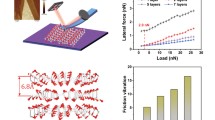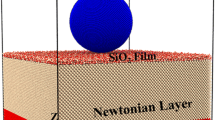Abstract
The most interesting phenomenon observed during nanoindentation of Si is the strain burst which occurs during unloading. This feature is referred to as a “pop-out” effect, and it is linked to the phase transformation that occurs underneath the indenter at high stresses. One of the peculiarities of this effect is the observed linear dependence between the depth at which the “pop-out” effect occurs and the maximum penetration depth. By performing a systematic study on the doped Si as well as on photovoltaic structures such as ITO/Si and SnO2/Si, it is shown that this linearity holds for different unloading rates, which strongly affects the “pop-out” appearance and contact pressure. Furthermore, it is illustrated that that phase transformation in the doped Si is delayed when it is coated with a thin film due to the tension preservation in the imprint under the film coating. This observation suggests that the mechanical properties at the interface between thin films and Si substrates in coated systems (MEMs and photovoltaics) should be further investigated.
Similar content being viewed by others
References
Kriese, M.D., Gerberich, W.W., and Moody, N.R., Quantitative adhesion measures of multilayer films: Part I. Indentation mechanics, J. Mat. Res., 1999, vol. 14, no. 7, pp. 3007–3018.
Gerberich, W.W., Kramer, D.E., Tymiak, N.I., Volinsky, A.A., Bahr, D.F., and Kriese, M.D., Nanoindentation-induced defect-interface interactions: phenomena, methods and limitations, Acta Mat., 1999, vol. 47, no. 15, pp. 4115–4123.
Kriese, M.D., Boismier, D.A., Moody, N.R., and Gerberich, W.W., Nanomechanical fracture-testing of thin films, Eng. Fract. Mech., 1998, vol. 61, pp. 1–20.
Volinsky, A.A., Moody, N.R., and Gerberich, W.W., Inter-facial toughness measurements for thin films on substrates, Acta Mat., 2002, vol. 50, pp. 441–466.
Stone, D., LaFontaine, W.R., Alexopoulos, P., Wu, T.W., and Li, C.-Y., An investigation of hardness and adhesion of sputter-deposited aluminum on silicon by utilizing a continuous indentation test, J. Mater. Res., 1988, vol. 3, no. 01, pp. 141–147.
Pharr, G.M., Oliver, W.C., and Clarke, D.R., The mechanical behavior of silicon during small-scale indentation, J. Electron. Mater., 1990, vol. 19, no. 9, pp. 881–887.
Bradby, J.E., Williams, J.S., Wong-Leung, J., Swain, M.V., and Munroe, P., Transmission electron microscopy observation of deformation microstructure under spherical indentation in silicon, Appl. Phys. Lett., 2000, vol. 77, p. 3749.
Zarudi, I., Zhang, L.C., Cheong, W.C.D., and Yu, T.X., The difference of phase distributions in silicon after indentation with berkovich and spherical indenters, Acta Materialia, 2005, vol. 53, pp. 4795–4800.
Hu Huang, Hongwei Zhao, Chengli Shi, Lin Zhang, Shunguang Wan, and Chunyang Geng, Randomness and statistical laws of indentation-induced pop-out in single crystal silicon, Materials, 2013, vol. 6, no. 4, pp. 1496–1505.
Gerk, A.P. and Tabor, D., Indentation hardness and semiconductor-metal transition of germanium and silicon, Nature, 1978, vol. 271, pp. 732–733.
Zarudi, I., Zou, J., and Zhang, L.C., Microstructures of phases in indented silicon: a high rezolution characterization, Appl. Phys. Lett., 2003, vol. 82, no. 6, pp. 874–876.
Grabko, D.Z. and Harea, E.E., “Pop-out” effect in ITO/Si and SnO2/Si structures, Surf. Eng. Appl. Electrochem., 2013, vol. 49, no. 1, pp. 36–41.
Yan, J.W., Takahashi, H., Gai, X.H., Harada, H., Tamaki, J., and Kuriyagawa, T., Load effects on the phase transformation of single-crystal silicon during nano-indentation tests, Mater. Sci. Eng. A, 2006, vol. 423, pp. 19–23.
Bradby, J.E., Williams, J.S., Wong-Leung, J., Swain, M.V., and Munroe, P., Mechanical deformation in silicon by micro-indentation, J. Mater. Res., 2001, vol. 16, no. 5, pp. 1500–1507.
Domnich, V., Gogotsi, Y., and Dub, S., Effect of phase transformations on the shape of the unloading curve in the nanoindentation of silicon, Appl. Phys. Lett., 2000, vol. 76, no. 16, pp. 2214–2216.
Liu, Y.H., Chen, T.C., Yang, P.F., Jian, S.R., and Lai, Y.S., Atomic-level simulations of nanoindentation-induced phase transformation in mono-crystalline silicon, Appl. Surf. Sci., 2007, vol. 254, pp. 1415–1422.
Rao, R., Bradby, J.E., and Williams, J.S., Patterning of silicon by indentation and chemical etching, Appl. Phys. Lett., 2007, vol. 91, no. 12, p. 123113.
Simashkevich, A.V., Sherban, D.A., Bruk, L.I., Kharya, E.E., and Usatii, Iu., Efficient ITO/nSi solar cells with silicon textured surface, Surf. Eng. Appl. Electrochem., 2011, vol. 47, no. 3, pp. 266–271.
Yin Zhi Chen, Hong Chuan Jiang, Shu Wen Jiang, Xing Zhao Liu, and Wan Li Zhang, Thin film thermocouples for surface temperature measurement of turbine blade, Advanced Materials Research, 2014, vol. 873, pp. 420–425.
Kai Wah Yeung and Chung Wo Ong, Micro-pressure sensors made of indium tin oxide thin films, Sensors and Actuators A, 2007, vol. 137, pp. 1–5.
Gregory, O.J. and Tao You, Piezoresistive properties of ITO strain sensors prepared with controlled nanoporosity, J. Electrochem. Soc., 2004, vol. 151, no. 8, pp. H198–H203.
Simashkevich, A., Sherban, D., Bruc, L., Coval, A., Fedorov, V., Bobeico, E., and Usatii, Iu., Spray deposited ITO/nSi solar cells with enlarged area, Proc. of the 20th European Photovoltaic Solar Energy Conference, Barcelona, Spain, 2005, pp. 980–982.
ISO 14577-4: Test Method for Metallic and Nonmetallic Coatings.
Oliver, W.C. and Pharr, G.M., Measurement of hardness and elastic modulus by instrumented indentation: advances in understanding and refinements to methodology, J. Mater. Research, 2004, vol. 19, no. 1, pp. 3–20.
Rosenfeld, L.G., Ritter, J.E., Lardner, T.J., and Lin, M.R., Use of the microindentation technique for determining interfacial fracture energy, J. Appl. Phys., 1990, vol. 67, no. 7, pp. 3291–3296.
Fischer-Cripps, A., Nanoindentation. Mechanical Engineering Series 1, Springer Science+Business Media, LLC 2011.
Juliano, T., Gogotsi, Yu., and Domnich, V., Effect of indentation unloading conditions on phase transformation induced events in silicon, J. Mater. Res., 2003, vol. 18, no. 5, pp. 1192–1201.
Author information
Authors and Affiliations
Corresponding author
Additional information
The article is published in the original.
About this article
Cite this article
Harea, E.E., Aifantis, K.E. Understanding the evolution of the pop-out effect in Si-based structures for photovoltaics. Surf. Engin. Appl.Electrochem. 50, 497–503 (2014). https://doi.org/10.3103/S1068375514060040
Received:
Accepted:
Published:
Issue Date:
DOI: https://doi.org/10.3103/S1068375514060040




